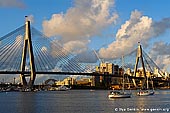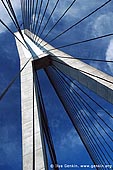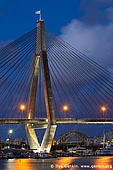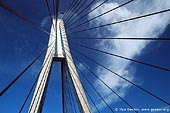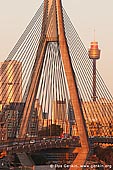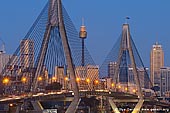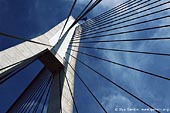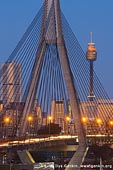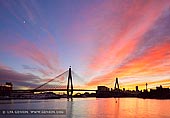ANZAC Bridge
Sydney, NSW, Australia
Related subjects: Sydney Harbour Bridge, Transport in Sydney
Related subjects: Sydney Harbour Bridge, Transport in Sydney
The Anzac Bridge spanning Johnstons Bay is one of Sydney's more recent landmarks. It was completed in 1995 to replace the former Glebe Island Bridge, a century old electrically operated swing bridge that was in operation since 1901, and provides a key link between Sydney City and the suburbs to the west via Victoria Road and an east-west route from the city to the M4 motorway at Concord.
Anzac Bridge has a main span of 345 metres, and a total length of more than 800 metres. From two 120-metre-high towers, 128 stay cables support the reinforced concrete deck. It is the longest cable-stayed span bridge in Australia and among the longest concrete cable-stayed span bridges in the world.
It was criticised by some as 'over-engineered' because of its size – with seven lanes for traffic. The criticism proved unfounded as the bridge was reconfigured for eight traffic lanes in 2005.
The bridge was given its current name on Remembrance Day in 1998 to honour the memory of the soldiers of the Australian and New Zealand Army Corps (ANZAC) who served in World War I. An Australian Flag flies atop the eastern pylon and a New Zealand Flag flies atop the western pylon.
The bridge featured two fixed truss spans and an electronically operated swing span. The swing spans were among the largest in the world at the time the bridge was built and some of the earliest to be powered by electricity. The power came from the nearby Ultimo Power House which also powered Sydney’s trams. The four-lane bridge carried significant traffic loads and was in use until the opening of the current bridge.
About the Artist
I'm Ilya Genkin - an internationally recognised Australian landscape and fine art photographer offering wall art prints. My passion for capturing the beauty of nature and our world translates into striking photographic prints that bring life, emotion, and inspiration to any space. From tranquil seascapes to dramatic mountainscapes, each image is a reflection of my vision and dedication to the art of photography.
Read more about Ilya Genkin and shop fine art prints online from his collection.
Wall Art Prints Featuring Fine Art Landscape Photography
Explore my extensive collection of wall art prints - crafted with the highest-quality materials to suit every style and budget. Whether you're looking for a luxurious, ready-to-hang piece or a beautifully printed work to frame yourself, each photograph is available in several premium formats: Gallery-quality Fine Art Paper Prints - ready for framing, and Professional Canvas Prints - classic and timeless texture.
Each artwork is meticulously printed and made-to-order to ensure you receive a piece that elevates your home, office, or commercial space. Buy fine art prints online to suit your style.
Artworks for Interior Designers, Home Stylists, and Architects
I collaborate with interior designers, home stylists, and architects to create bespoke wall art prints tailored to your project's aesthetic, colour palette and interior design needs. Prints can be customised and sized to complement your space perfectly. All pieces are made-to-order, and pricing varies based on size, quantity, and shipping.
Contact me to discuss your project and request a personalised quote.
Why Choose Ilya Genkin Photography?
By choosing my work, you're not just acquiring exceptional art - you're supporting an independent Australian artist and contributing to a vibrant local creative community. Every purchase directly helps sustain and grow this craft, bringing authentic and meaningful art into your life.
Request a free mockup to see how a chosen photograph will look in your space before you buy.
Start your journey today - shop our wall art collection, purchase with confidence, or order custom prints today and transform your walls with fine art photography.
Fine Art Landscape Photography
Information
- FAQ - Landscape Photography Prints
- Purchase Fine Art Prints
- Black and White Fine Art Prints
- Art Consultation for Your Home
- Design Tips for Styling Your Space with Art
- Limited Edition vs Open Edition Prints
- Collector Resources
- FAQ - Image Licensing
- License Stock Photos
- Stock Photo Price Request
- Materials and Sustainability
Photography Guides
Online Store Opens 24/7
Email:
Phone: +61 (0) 421 055 613
Crafted with care for the planet - using sustainable materials and eco-friendly packaging.
Ilya Genkin Photography acknowledges the Traditional Custodians of the land on which we operate, live and gather as employees, and recognise their continuing connection to land, water and community. We pay respect to Elders past, present and emerging.
